
Grötlingbo Church is a medieval church in Grötlingbo on the Swedish island Gotland. The stately Gothic church contains elements of a Romanesque frieze, incorporated from an earlier church building on the same site. Görtlingbo Church lies within the Diocese of Visby.
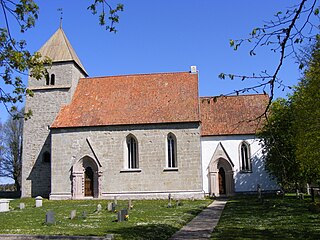
Hablingbo Church is a medieval church in Hablingbo on the Swedish island of Gotland. It is one of the largest churches on Gotland, and dating largely from the 14th century, although the current church building was preceded by a stave church. The stone portals of the church are comparatively richly decorated. It is used by the Church of Sweden and part of the Diocese of Visby.

Martebo Church is a medieval church on the Swedish island of Gotland. Its three portals contain some of the richest medieval sculpture on the island. Martebo Church lies in the Diocese of Visby.

Tingstäde Church is a medievalchurch on the Swedish island of Gotland, in the Diocese of Visby. Its present appearance dates largely from the 13th and 14th centuries.
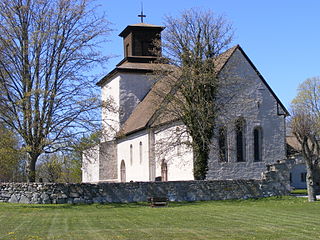
Vamlingbo Church is a medieval church on the Swedish island of Gotland, and one of the largest on the island. It lies in the Diocese of Visby.

Öja Church is a medieval church in Öja on the Swedish island of Gotland. The church dates from the 13th century and contains an unusual large and elborately decorated triumphal cross or rood. It belongs to the Church of Sweden and lies in the Diocese of Visby.

Alva Church is a medieval church in Alva on the Swedish island of Gotland. The oldest parts of the church date from the late 12th century; with the halted construction of the tower about a century later, building activity ceased. The church contains medieval murals as well as a number of medieval furnishings and pieces of art. It lies in the Diocese of Visby of the Church of Sweden.

Hörsne Church is a medieval church in Hörsne-Bara on the Swedish island of Gotland. Dating from the 13th to the 14th century, the church has unusually richly decorated portals. It belongs to the Diocese of Visby of the Church of Sweden.

Eke Church is a medieval church in Eke on the Swedish island of Gotland. The church was built during the 12th and 13th century, with only smaller additions and changes made later. Inside, several medieval murals survive. The church is used by the Church of Sweden and lies in the Diocese of Visby.
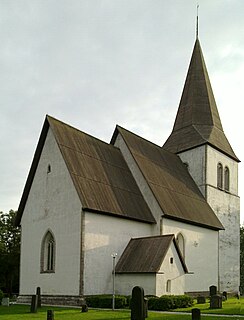
Etelmhem Church is a medieval church on the Swedish island of Gotland. The largely Gothic church contains medieval murals and a 12th-century baptismal font by the sculptor Hegvald. The church is used by the Church of Sweden and part of Diocese of Visby.

Boge Church is a medieval church in Boge not far from Slite on the Swedish island of Gotland. Its main construction period was during the 13th century, but the tower was rebuilt following its collapse in a storm during the 19th century. It contains sets of medieval murals. It belongs to the Church of Sweden and lies in the Diocese of Visby.

Bäl Church is a medieval church in Gute, Bäl, on the Swedish island of Gotland. It was built during the first half of the 13th century and contains sculptural decoration in both Romanesque and Gothic styles. The interior is decorated by medieval wall paintings. It belongs to the parish Väskinde, in the Diocese of Visby.

Ekeby Church is a medieval church in Ekeby on the Swedish island of Gotland. The oldest parts date from the 12th century, and the church has been little altered since the end of the 13th century. Its interior is richly decorated with medieval murals. It belongs to the Church of Sweden and lies in the Diocese of Visby.

Endre Church is a medieval church in Endre on the Swedish island of Gotland, in the Diocese of Visby, built from the 12th to early 14th century. It contains medieval murals and several medieval furnishings, and belongs to the Church of Sweden.
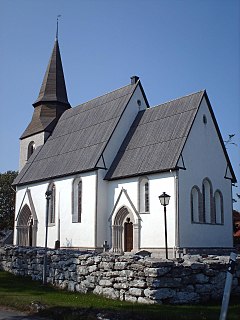
Fole Church is a medieval church in Fole on the Swedish island of Gotland. The Romanesque tower is the oldest part of the otherwise largely Gothic church. It belongs to the Church of Sweden and lies in the Diocese of Visby.
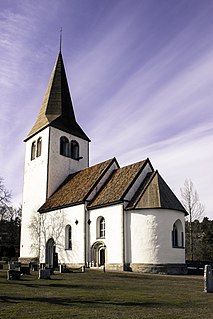
Linde Church is a medieval church on the Swedish island of Gotland. The church was built between the 12th and the early 13th century and is Romanesque in style. I lies in the Diocese of Visby.

Roma Church is a medieval church in Lövsta, Gotland (Sweden). The church is one of the largest countryside churches on Gotland. Built during the 13th century, it displays influences from Cistercian architecture and may have been used by Dominicans preaching for the Northern Crusades. It belongs to the Church of Sweden and lies in the Diocese of Visby.
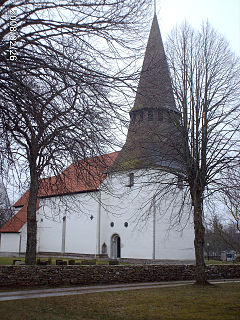
Hogrän Church is a medieval church in Hogrän on the Swedish island of Gotland. It was built in stages between the 12th and 14th century, and contains several medieval church fittings. It belongs to the Church of Sweden and lies in the Diocese of Visby.

När Church is a medieval church on the Swedish island Gotland. It belongs to the Church of Sweden and lies in the Diocese of Visby.

Vall Church is a medieval church on the Swedish island of Gotland. The largely Romanesque church dates from the 13th century. It belongs to the Diocese of Visby.























